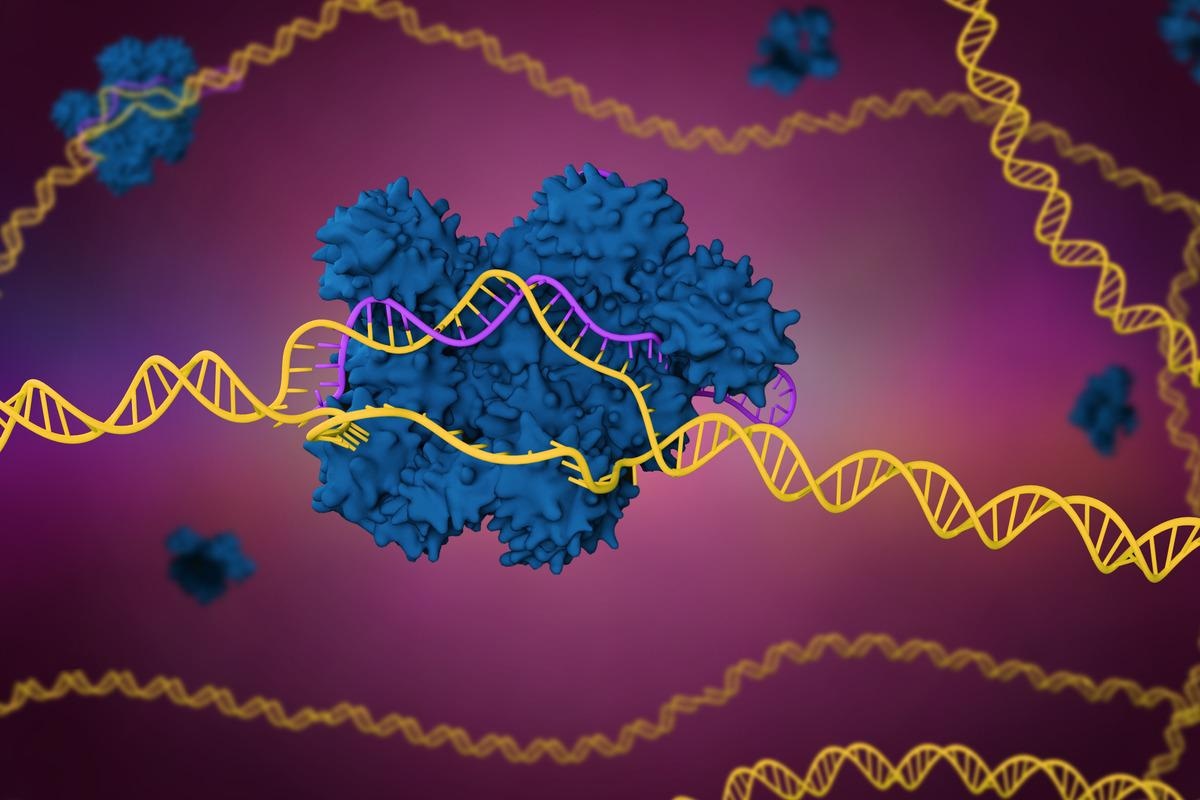 By Neha MathurReviewed by Danielle Ellis, B.Sc.Apr 14 2022
By Neha MathurReviewed by Danielle Ellis, B.Sc.Apr 14 2022In a recent study published in the journal Nano Today, researchers reviewed non-viral nano-vectors used for delivering the clustered regularly interspaced short palindromic repeats (CRISPR)/Cas9-mediated genome editing system. In particular, the researchers examined recent advancements in three nano-vectors, viz., lipid-based, polymer-based, and polymer inorganic nano-vectors.

Study: Nano-vectors for CRISPR/Cas9-mediated genome editing. Image Credit: Meletios Verras/Shutterstock
Background
It is noteworthy that the CRISPR/Cas9 genome editing cargoes include Cas9-deoxyribonucleic acid (DNA) plasmid, Cas9-messenger ribonucleic acid (mRNA), and Cas9-ribonucleoprotein (RNP).
The study demonstrated the therapeutic applications of all the three components of the CRISPR/Cas9 genome-editing system, focusing on their usage in treating cancers and genetic diseases via two major gene-editing pathways- homology-directed repair (HDR) pathway and non-homologous end-joining (NHEJ) pathway.
Lipid-based nano-vectors were the first to be adapted for delivering small interfering RNA (siRNA) and mRNA. They can efficiently load all the three types of payloads, viz., Cas9 DNA plasmid, Cas9 RNP, and Cas9 mRNA, via electrostatic interaction, achieving superior delivery performance. Although safer than polymer-based nano-vectors, lipid-based nano-vectors exhibit poor colloidal stability when used in vivo.
The poor biodegradability of several inorganic compositions of polymers, including gold nanoparticles, silica, black phosphate nanosheet, and graphene oxide, should be addressed as an impeding factor in their clinical translation.
Safe and efficient delivery of the CRISPR/Cas9 genome-editing system in vivo remains challenging. Physical approaches, including electroporation, microinjection, and hydrodynamic injection, were used for both in vitro and ex vivo gene editing. However, these approaches could not be adopted for clinical translation due to poor delivery performance and potential physiological complications. The primary concern with currently used viral vectors, such as adenovirus and lentivirus, was safety.
Overall, non-viral nano-vectors exhibit profound advantages over physical approaches and virus-based delivery. In vivo, they prevent degradation of the CRISPR/Cas9 genome-edition system; moreover, they are typically easier to scale up, produce, and modify chemically. Plus, they are cost-effective, have large packaging capacity, and lower immunogenicity.
Nano-vectors for delivery of Cas9 DNA plasmid, Cas9 mRNA, and Cas9 RNP
The cationic lipid-based nano-vectors were adapted first for the DNA plasmid delivery-encoding CRISPR/Cas9 and single-guide RNA (sgRNA). In a recent work by Jiang et al., polyethylene glycol phospholipid-modified cationic lipid nanoparticle (PLNP) encapsulated Cas9 DNA plasmids and attained over 47% transfection efficiency in human malignant melanoma cells. However, the positive charges of cationic lipid-based nanovectors introduce toxicity into biological systems.
Researchers developed the cholesterol-terminated polymer-based nano-vectors with low cytotoxicity and high transfection efficacy to address this. These showed great potential for treating heart diseases, and their intravenous injection into C57BL/6 J mice induced disruption of the fibrillin 1 (Fbn1) gene, resulting in aortic diameter dilation.
A group of researchers developed a selective organ targeting (SORT) nano-vector system to selectively target specific tissues of the lungs, spleen, and liver. The SORT system selectively targeted several cell types, including epithelial cells, endothelial cells, B cells, T cells, and hepatocytes, for genetic therapies.
The in vivo mRNA delivery using optimized N1, N3, N5-tris(2-aminoethyl)benzene-1,3,5-tricarboxamide (TT) 3 lipid nanoparticles delivered Cas9 mRNA to the liver of C57BL/6 mice. This therapeutically targeted hepatitis B virus (HBV) DNA and proprotein convertase subtilisin/kexin type 9 (Pcsk9) gene.
Recently, a biodegradable lipid-based nano-vector system significantly disrupted the mouse transthyretin (TTR) gene in the liver, achieving over 97% reduction in the TTR serum protein levels. This effect persisted for at least 12 months via a single systemic administration, hence could be used to treat diseases such as TTR amyloidosis and hepatitis B.
Another noteworthy lipid Cas9 mRNA nano-vector is NTLA-2001. A clinical trial reported that six patients with TTR amyloidosis treated with one dose of NTLA-2001 showed a decrease in the serum TTR protein concentration with only mild adverse events at day 28 post-treatment.
A wide range of nano-vectors, including lipid-based, polymer-based, and polymer-inorganic, have been developed for Cas9 RNP delivery. Interestingly, nano-vectors loaded with Cas9 RNP can directly enter the nucleus to perform CRISPR/Cas9-mediated genome editing.
A poly (d,l-lactide-co-glycolide) (PLGA)-based nano-vector for Cas9 RNP delivery disrupts γ-globin gene promoter in erythroid cells, abolishing the binding of fetal hemoglobin (HbF) transcriptional repressors, offering a therapeutic solution for hemoglobinopathies.
Due to their high surface area, mesoporous silica nanoparticles (MSN) were used for engineering a nano-vector lipoMSN that enabled efficient electrostatic loading of Cas9 RNP.
Its administration in C57BL/6 J mice led to a significant reduction in serum triglycerides and cholesterol levels, disrupting two genes- Pcsk9 and angiopoietin-like 3 (Angptl3).
Conclusions
The study showed the feasibility of administering Cas9 DNA plasmid, mRNA, and RNP systemically or locally into organs affected by genetic disorders or cancers, including the brain, eyes, lungs, liver, muscles, and tumors.
In the future, non-viral vectors might become efficient carriers of the CRISPR/Cas9 genetic cargos that mediate disruptions of multiple oncogenes, such as the programmed death-ligand 1 (PD-L1) gene, for more effective cancer cell treatment.
Another application of the non-viral nano-vectors could be for genetic disorder treatments. Conceptually, gene correction or insertion can treat most genetic diseases, as they manifest only due to single or multiple mutations in the respective genes. However, advancements in inserting long-frame therapeutic genes have not been very successful until now, the NHEJ-based gene insertion is seemingly adaptable to achieve more efficient CRISPR/Cas9-mediated insertion in vivo.
Lipid-based nano-vectors have successfully and efficiently delivered the severe acute respiratory syndrome coronavirus 2 (SARS-CoV-2) mRNA vaccines; however, further research is needed before the next-generation nano-vectors with the potential to deliver the CRISPR/Cas9 genome-editing system, especially Cas9 mRNA, become available.
Future research could alleviate or abolish issues with non-viral nano-vectors, such as toxicity, size dispersity, purity, by-products, large-scale manufacturing, and scalability. Yet, they would need to conform to the Current Good Manufacturing Practice (CGMP) regulations.
After meeting the aforementioned requirements, the next-generation nano-vectors delivering the CRISPR/Cas9 genome-editing system for treating cancers and genetic disorders would become available for clinical applications.